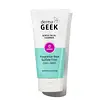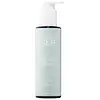What's inside
What's inside
 Key Ingredients
Key Ingredients

No key ingredients
 Benefits
Benefits

 Concerns
Concerns

 Ingredients Side-by-side
Ingredients Side-by-side

Water
Skin ConditioningCocamidopropyl Betaine
CleansingDisodium Cocoamphodipropionate
CleansingSodium Lauroyl Sarcosinate
CleansingSodium Lauryl Sulfoacetate
CleansingPropanediol
SolventSodium Coco Pg-Dimonium Chloride Phosphate
CleansingCaprylyl Glycol
EmollientPolyquaternium-10
Fructosyl Cocoate/Olivate
EmollientSodium Chloride
MaskingGlyceryl Laurate
EmollientPhenoxyethanol
PreservativeSodium Cocoyl/Olivoyl Hydrolyzed Oat/Wheat Protein
CleansingPotassium Sorbate
PreservativeAllantoin
Skin ConditioningPanthenol
Skin ConditioningCocamidopropyl Dimethylamine
EmulsifyingSodium Glycolate
BufferingHexylene Glycol
EmulsifyingCitric Acid
BufferingCocoyl Hydroxyethyl Imidazoline
Methyl Alcohol
SolventLavandula Angustifolia Oil
MaskingAlgae Extract
EmollientCocos Nucifera Oil
MaskingGardenia Taitensis Flower Extract
Skin ConditioningTocopherol
AntioxidantPhyllanthus Emblica Fruit Extract
HumectantLinalool
PerfumingWater, Cocamidopropyl Betaine, Disodium Cocoamphodipropionate, Sodium Lauroyl Sarcosinate, Sodium Lauryl Sulfoacetate, Propanediol, Sodium Coco Pg-Dimonium Chloride Phosphate, Caprylyl Glycol, Polyquaternium-10, Fructosyl Cocoate/Olivate, Sodium Chloride, Glyceryl Laurate, Phenoxyethanol, Sodium Cocoyl/Olivoyl Hydrolyzed Oat/Wheat Protein, Potassium Sorbate, Allantoin, Panthenol, Cocamidopropyl Dimethylamine, Sodium Glycolate, Hexylene Glycol, Citric Acid, Cocoyl Hydroxyethyl Imidazoline, Methyl Alcohol, Lavandula Angustifolia Oil, Algae Extract, Cocos Nucifera Oil, Gardenia Taitensis Flower Extract, Tocopherol, Phyllanthus Emblica Fruit Extract, Linalool
Ingredients Explained
These ingredients are found in both products.
Ingredients higher up in an ingredient list are typically present in a larger amount.
Citric Acid is an alpha hydroxy acid (AHA) naturally found in citrus fruits like oranges, lemons, and limes.
Like other AHAs, citric acid can exfoliate skin by breaking down the bonds that hold dead skin cells together. This helps reveal smoother and brighter skin underneath.
However, this exfoliating effect only happens at high concentrations (20%) which can be hard to find in cosmetic products.
Due to this, citric acid is usually included in small amounts as a pH adjuster. This helps keep products slightly more acidic and compatible with skin's natural pH.
In skincare formulas, citric acid can:
While it can provide some skin benefits, research shows lactic acid and glycolic acid are generally more effective and less irritating exfoliants.
Most citric acid used in skincare today is made by fermenting sugars (usually from molasses). This synthetic version is identical to the natural citrus form but easier to stabilize and use in formulations.
Read more about some other popular AHA's here:
Learn more about Citric AcidCocamidopropyl Betaine is a fatty acid created by mixing similar compounds in coconut oil and dimethylaminopropylamine, a compound with two amino groups.
This ingredient is a surfactant and cleanser. It helps gather the dirt, pollutants, and other impurities in your skin to be washed away. It also helps thicken a product and make the texture more creamy.
Being created from coconut oil means Cocamidopropyl Betaine is hydrating for the skin.
While Cocamidopropyl Betaine was believed to be an allergen, a study from 2012 disproved this. It found two compounds in unpure Cocamidopropyl Betaine to be the irritants: aminoamide and 3-dimethylaminopropylamine. High-grade and pure Cocamidopropyl Betaine did not induce allergic reactions during this study.
Learn more about Cocamidopropyl BetaineChances are, you eat sodium chloride every day. Sodium Chloride is also known as table salt.
This ingredient has many purposes in skincare: thickener, emulsifier, and exfoliator.
You'll most likely find this ingredient in cleansers where it is used to create a gel-like texture. As an emulsifier, it also prevents ingredients from separating.
There is much debate on whether this ingredient is comedogenic. The short answer - comedogenic ratings don't tell the whole story. Learn more about comegodenic ratings here.
The concensus about this ingredient causing acne seems to be divided. Research is needed to understand if this ingredient does cause acne.
Scrubs may use salt as the primary exfoliating ingredient.
Learn more about Sodium ChlorideSodium Lauroyl Sarcosinate is a cleansing agent and emulsifier. It is a surfactant derived from sarcosine, and a common source is coconut oil.
As a surfactant, Sodium Lauroyl Sarcosinate helps lift dirts, oil, and other molecules to be washed away. In leave-on products, this ingredient is used as an emulsifier. Emulsifier help prevent ingredients such as oils and waters from separating.
Sodium Lauroyl Sarcosinate is also commonly found as a foaming agent in shampoo, toothpaste, and shaving foam. It is amphiphilic, meaning it loves both water and fats.
Learn more about Sodium Lauroyl SarcosinateWater. It's the most common cosmetic ingredient of all. You'll usually see it at the top of ingredient lists, meaning that it makes up the largest part of the product.
So why is it so popular? Water most often acts as a solvent - this means that it helps dissolve other ingredients into the formulation.
You'll also recognize water as that liquid we all need to stay alive. If you see this, drink a glass of water. Stay hydrated!
Learn more about Water